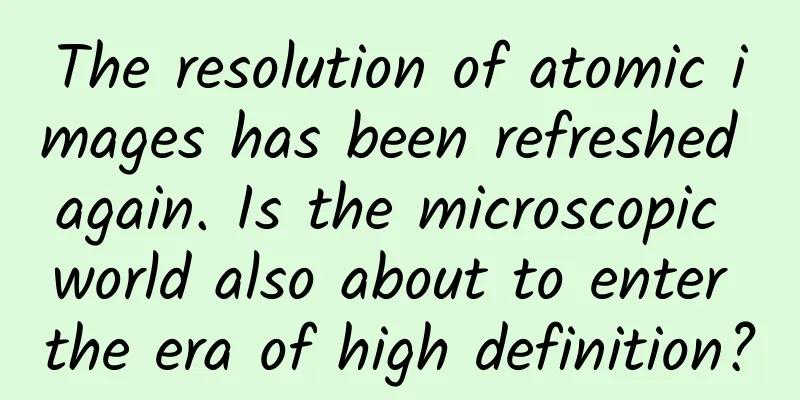The resolution of atomic images has been refreshed again. Is the microscopic world also about to enter the era of high definition?

|
Scanning tunneling microscope Scanning Tunneling Microscope Scanning Tunneling Microscope is abbreviated as STM. As a scanning probe microscopy tool, the scanning tunneling microscope allows scientists to observe and locate individual atoms, and it has a higher resolution than its counterpart, the atomic force microscope. In addition, the scanning tunneling microscope can precisely manipulate atoms using the probe tip at low temperatures (4K), so it is both an important measurement tool and a processing tool in nanotechnology. 100 million times resolution and beyond As early as 2018, researchers at Cornell University created a high-performance STM tunnel scanning detector, combined with the latest algorithm-driven so-called typchography, which tripled the resolution of state-of-the-art electron microscopes and achieved a world record of 100 million times magnification. But despite this success, the method has a weakness. It only works on ultrathin samples, a few atoms thick. Any thicker and the electrons scatter in ways that are impossible to unravel and image. Now, a team led again by David Mueller, the Samuel B. Eckert Professor of Engineering, has tripled their own 2018 record by using an electron microscope pixel array detector (EMPAD) combined with a more sophisticated 3D reconstruction algorithm. The image resolution is so fine that the only remaining blur is the thermal vibration of the atoms themselves! The latest atomic image magnified 100 million times "This is not only a new record," Mueller said. "We have reached a regime that is effectively the resolution limit. We can now basically figure out the positions of atoms very easily. This opens up a lot of new measurement possibilities for things we've wanted to do. It solves a problem that's been around for a long time -- eliminating multiple scattering of a beam in a sample (proposed by Hans Bethe in 1928), which is something we haven't been able to solve very well in the past." Gas chromatography works by scanning overlapping scattering patterns in a material sample and looking for changes in the overlapping areas. "We are chasing the light points of the pattern, much like your cat is fascinated by the light of a laser pointer!" Mueller said. "By looking at the changes in the pattern, we are able to calculate the shape of the object that caused the pattern." The detector is slightly defocused, blurring the beam, to capture the maximum range of data. This data is then reconstructed by complex algorithms, resulting in ultra-high-precision images with picometer (trillionth of a meter) accuracy. "With these new algorithms, we are now able to correct for all the blur of the microscope so that the biggest blur factor we have left is the fact that the atoms themselves are vibrating, because that's what happens to atoms above absolute zero," Mueller said. "When we talk about high and low temperatures, what we're actually measuring is the average strength of how much the atoms are vibrating." The scanning transmission electron microscope on the left sends a narrow beam of electrons through a sample, scanning back and forth to produce an image. The pixel array detector on the right reads the landing point and, from that landing point, the scattering angle of each electron, providing information about the atomic structure of the sample. The researchers might be able to improve their record again by using a material made of heavier atoms (which vibrate less) or by cooling the sample down, but even at absolute zero, atoms still have quantum fluctuations, so the improvement wouldn't be huge. This latest form of electron spectroscopy allows scientists to locate individual atoms in all three dimensions when they are hidden from other imaging methods. Researchers will also be able to spot impurity atoms in unusual structures one at a time and image them and their vibrations. This is particularly useful for imaging semiconductors, catalysts and quantum materials, including those used in quantum computing, and for analyzing atoms at the boundaries that connect materials together. This imaging method can also be applied to thick biological cells or tissues, or even to synaptic connections in the brain, which Mueller calls "connectomes on demand." Although the method is time-consuming and computationally intensive, it can be made more efficient using more powerful computers combined with machine learning and faster detectors. “We want to apply this to everything we do,” said Mueller, who co-directs Cornell’s Kavli Institute for Nanoscale Science and co-chairs the Nanoscale Science and Microsystems Engineering (NEXT Nano) working group, part of Cornell’s Radical Collaboration Initiative. “Until now, we’ve all been wearing really bad glasses. Now we actually have a really good pair of glasses. Why wouldn’t you want to take off your old glasses, put on new ones and use them all the time?” Brahma’s viewpoint: In the universe, even an atom is a world. |
<<: The "Jiuxiao Huanpei" Qin collected by the National Museum of China (Part 1)
>>: Popular Science Illustrations | What special “skills” does the “Red National Treasure” have?
Recommend
This seasonal rose-colored sea of flowers is actually called Pig
I still remember that it was the end of April, th...
How to improve user retention rate? Share 6 rules!
Retention rate is the most important criterion fo...
Goodbye, the good days of making money without doing anything using Alipay and WeChat Pay!
There are more and more signs that the era of wil...
Can short video operations be both eye-catching and easy to monetize?
Wearing traditional ethnic costumes, seven native...
WeChat subscription account messages are too annoying! Teach you how to turn off message push, simple and practical
1. Unfollow a subscription account [[416576]] Whe...
Can you buy near-expiry food at a 10% discount? Is it safe?
Have you ever bought expired food? When you go to...
Apple iOS 16.2 / iPadOS 16.2 Developer Preview Beta Released: New Borderless Notes App
On October 26, Apple pushed the iOS 16.2 / iPadOS...
Samsung S6 flash failure revealed
Recently, some foreign users have reported that S...
I recommend several H5 page creation tools, choose one for yourself!
Ever since micro scenes made with H5 became popul...
How does a new public account attract fans? How to quickly increase followers of WeChat public account?
When a new public account is opened and has no fa...
oCPC costs remain high? Come and try this method!
When delivering information flow, especially runn...
Some elephants are killed for their tusks, but many more starve to death for their molars. Why?
Elephants have very unique teeth, but the "u...
Is excess body fat obesity? How does a body fat scale know our fat content?
When a person decides to lose weight, the first t...
All the creative routines for high-click information flow in the 4 major industries are here!
As we all know, due to its own industry attribute...
Things to note when applying for 400 telephone numbers
Since its emergence, 400 telephones have graduall...









